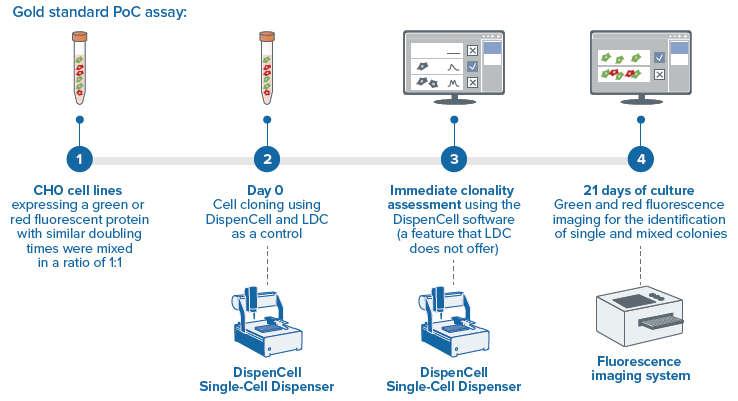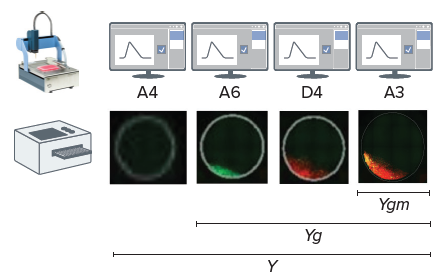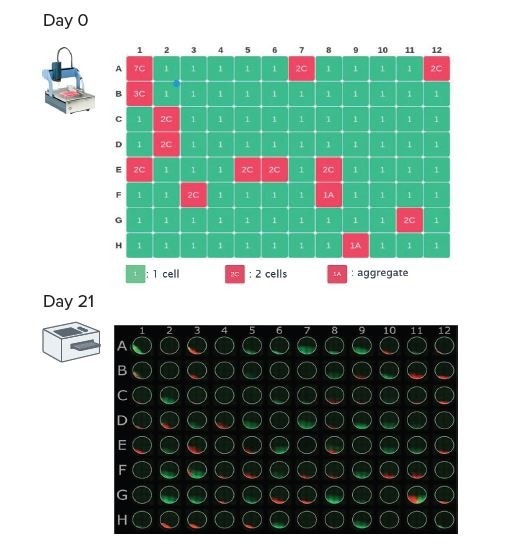Mammalian cell lines must be derivative of a single progenitor cell in industrial cell development. Because of this, regulatory agencies will ask that the probability of clonality (PoC) be evaluated to ensure they are safe enough for commercial manufacturing.
The PoC is an estimate of the probability that a production cell line has been derived from a single cell progenitor. These cloning protocols were stringently compared by Chen et al, who also evaluated their regulatory acceptance.1 The findings were then published in the reading, “Methods for Estimating the Probability of Clonality in Cell Line Development”.1 This research resulted in the development of a gold standard assay utilized by numerous organizations to estimate the PoC of their cell line development workflow.
- Traditionally, two sessions of cloning using limiting dilution cloning (LDC) transpire to arrive at a high PoC. This can add weeks to the process. There is pressure to find an alternative to LDC that can shrink the timeline but maintain a high PoC.
- DispenCell™ is a simple alternative to LDC due to its reliability, ease, and expense-efficient single-cell dispenser modeled after impedance technology.2
- The Chen et al. assay was used here to estimate the PoC of clones isolated utilizing the DispenCell and then compared to clones isolated utilizing LDC (Fig.1).1
Benefits
- Remarkably High PoC: An exceptional PoC of 98.4% was achieved by DispenCell, which was much higher than the 76.1% reached through LDC. This means the cell line development was robust and readily able to meet the exact regulatory standards outlined for safety in commercial manufacturing.
- Early-Stage Cloning Efficiency: Labor and resource expenditures were reduced due to the accelerated and streamlined cloning available with DispenCell.
- Improved Monoclonal Colony Yield: When compared to LDC, DispenCell offered a much greater quantity of monoclonal colonies. This is essential for success in cell line development, particularly when dealing with high-throughput industrial situations.
- Greater Confidence through Integrated Visual Confirmation: DispensCell allows for visual confirmation of monoclonality on Day 0 when paired with the fluorescence imaging system. This enhances the PoC and offers higher confidence in the cell line development process and a tough and proven method for IND (Investigational New Drug) application submissions.
Methods
CHO cells expressing GFP were mixed with RFP-expressing cells and then cloned using DispenCell and LDC as a control (N = 4 × 96-well plates, each). The PoC of the resulting clones was estimated using Chen’s model 1:
| Yg = Y × (1 - b) × a + Y × b × (1- (1 - a2)) |
(1) |
with the following variable parameters (Fig.1):
Y = wells defined as having one cell by the DispenCell
Yg = wells among Y showing cell outgrowth
Ygm = wells among Yg that are positive for both green and red fluorescence
a = single-cell recovery rate
b = probability of having two cells per well
(1) and (2) were combined, and the experimental data were added to obtain the variables a and b to compute the PoC :
| PoC = (Y × (1 - b) × a + Y × b × 2 × a × (1- a)) / Yg |
(3) |

Figure 1. Experimental design of the PoC assay. Image Credit: Molecular Devices UK Ltd

Figure 2. PoC assessment schematics for each well condition. Image Credit: Molecular Devices UK Ltd
Results
- Day 0 Cloning: The DispenCell software allows for a clonality check and aids in selecting 316 wells that demonstrate single-cell signatures. Figure 3 shows how the rejected wells are marked red and the selected wells are marked green. This selection process was not possible for the plates dispensed by LDC. Poisson distribution (0.6 cells/well) was used to estimate the number of wells containing one cell in LDC and arrived at 124.
- Day 21 Fluorescence imaging of the colonies: DispenCell selected 316 wells. Of these, 255 colonies were observed, with just two being bi-colored. The computed single-cell recovery rate (a) was 80%, and the probability of having two cells per well (b) was 2%. LDC provided 380 wells. Of these, 155 colonies were observed, 23 of which were bi-colored. The computed single-cell recovery rate (a) was 90%, and the probability of having two cells per well (b) was 26%.,
- The PoC of each method was arrived at by considering the single-cell recovery rate, a method based on the Chen et al. model (Fig. 4). The DispenCell PoC was 98.4%, and for the LDC, it was 76.1%.
- DispenCell provided a much higher PoC when compared to LDC, with double the monoclonal colonies.
- DispenCell’s impedance-based clonality assessment could be paired with a visual confirmation at Day 0 using a high-resolution imager (e.g., CloneSelect® Imager, Molecular Devices). This would further improve the PoC and support seamless, expedient, and confident IND filling.

Figure 3. Clonality check on Day 0 using the DispenCell analysis software (left panel) and imaging of colonies on Day 21 using fluorescent imaging (right panel). Image Credit: Molecular Devices UK Ltd
| |
DispenCell |
LDC |
| Total wells |
372 |
380 |
| Monoclonal wells–Day 0 |
316 (impedance-based) |
124* (estimated) |
| Total wells with colonies–Day 21 |
255 (observed) |
155 (observed) |
| Wells with mixed colonies–Day 21 |
2 (observed) |
23 (observed) |
| Probability of clonality (PoC) |
98.4% |
76.1%* |
| Monoclonal colonies |
251 |
118* (estimated) |
* Computed using the Poisson distribution-based model with 0.6 cells/well and taking into account cell survival statistics.
Figure 4. Experimental data analysis for PoC calculation. Image Credit: Molecular Devices UK Ltd
References and Further Reading
- Chen et al., 2020. ‘Methods for Estimating the Probability of Clonality in Cell Line Development’, Biotechnol J. 15(2):e1900289.
- Hannart et al., 2022. Traceable Impedance-based single cell pipetting: from a research set-up to a robust and fast automated robot’, SLAS TECHNOL. 27(2):121–129.
About Molecular Devices UK Ltd 
Molecular Devices is one of the world’s leading providers of high-performance life science technology. We make advanced scientific discovery possible for academia, pharma, and biotech customers with platforms for high-throughput screening, genomic and cellular analysis, colony selection and microplate detection. From cancer to COVID-19, we've contributed to scientific breakthroughs described in over 230,000 peer-reviewed publications.
Over 160,000 of our innovative solutions are incorporated into laboratories worldwide, enabling scientists to improve productivity and effectiveness – ultimately accelerating research and the development of new therapeutics. Molecular Devices is headquartered in Silicon Valley, Calif., with best-in-class teams around the globe. Over 1,000 associates are guided by our diverse leadership team and female president that prioritize a culture of collaboration, engagement, diversity, and inclusion.
To learn more about how Molecular Devices helps fast-track scientific discovery, visit www.moleculardevices.com.
Sponsored Content Policy: AZO Life Sciences publishes articles and related content that may be derived from sources where we have existing commercial relationships, provided such content adds value to the core editorial ethos of AZO Life Sciences which is to educate and inform site visitors interested in medical research, science, medical devices and treatments.